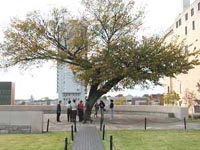Resource Library
Plant of the Week: Survivor Tree (American Elm in Oklahoma City)
The University of Arkansas System Division of Agriculture does not promote, support or recommend plants featured in "Plant of the Week." Please consult your local Extension office for plants suitable for your region.
Plant of the Week
Survivor Tree (American Elm)
Latin: Ulmus americana

At the Oklahoma City National Memorial, the site of the 1995 bombing of the Murrah Federal Building, stands the Survivor Tree. The tree stands guard over a native stone plaza and its courtyard of 168 empty chairs. The fact that the tree survived the bomb blast that killed so many transformed it from a mere tree to a talisman for the comfort of all who survived.
That a tree should take on such symbolism in the aftermath of a tragedy is hardly surprising. Mankind has long placed significance on its venerable old trees, and the greater the age or the more momentous the event surrounding them, the more important they become.
The Survivor tree is an American elm, Ulmus americana. While the species is capable of attaining a height and spread of more than 100 feet, this tree is more modest in its stature with dimensions of about 40 feet. Photos taken in the 1920's when the property was the back yard of a family home indicate the tree is about 100 years old. The tree’s low-forked trunk is tilted at an odd angle and, were the circumstance different, it would have hardly attracted visitors’ notice.
But in the aftermath of the blast, the off-balanced yet well-rooted stature of the tree make it a perfect symbol for survival. It seems to proclaim to all who enter the hallowed site and will pause a moment to listen that the senseless act of destruction perpetrated by the few will not be the final word. The very fibers of its bole seem to radiate hope for the future just as a lighthouse sends its light into the dark night.
Chronicling the story of our nation’s historic trees has never been a very organized affair, yet individuals with a sense of history and biology occasionally come forth with compilations of historic trees. To my knowledge, the first such attempt was during the Civil War by Harper’s New Monthly Magazine, which described many of the significant trees from the Colonial era.
A modern account of historic trees was prepared during the height of the green movement when the editors of Outdoor Life published Trees of America in 1973. Because trees are transient and events of importance are constantly changing, an updated version is sorely needed for those of us interested in this small slice of Americana.
During the last decade the folks at the National Arbor Day Foundation have been selling seedlings or grafts of historic trees. While these trees may not have superior horticultural characteristics, their historic significance is great. Every plant in a landscape has a story to tell and these historic trees can serve as a touchstone to our past.
I don’t know if there have been efforts to propagate the Survivor Elm. While there may be considerable interest in doing so, it is probably not the best idea. American elms are highly susceptible to Dutch elm disease and the fact that this tree has survived probably has more to the fact it is located at the western extent of the trees range than with any inherent resistance to the disease. Several disease resistant American elms are now being grown by wholesale nurserymen so gardeners interested in growing a venerable elm for their landscape would be better advised to seek out one of these for planting.
By: Gerald Klingaman, retired
Extension Horticulturist - Ornamentals
Extension News - May 16, 2000
The University of Arkansas System Division of Agriculture does not maintain lists of retail outlets where these plants can be purchased. Please check your local nursery or other retail outlets to ask about the availability of these plants for your growing area.